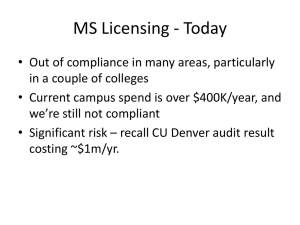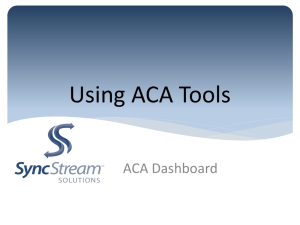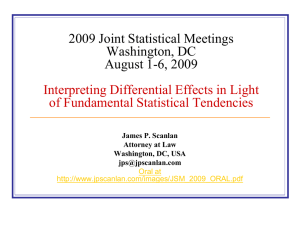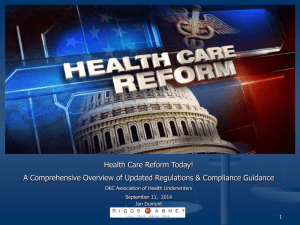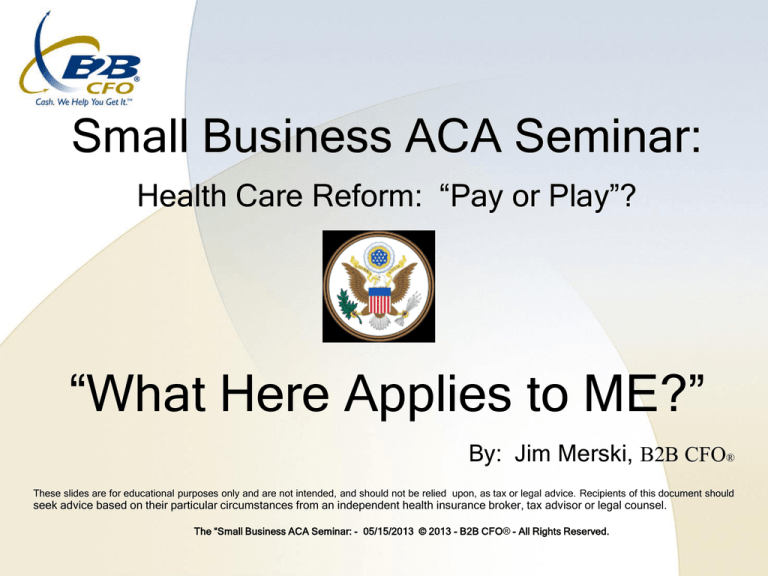
Small Business ACA Seminar:
Health Care Reform: “Pay or Play”?
“What Here Applies to ME?”
By: Jim Merski, B2B CFO®
These slides are for educational purposes only and are not intended, and should not be relied upon, as tax or legal advice. Recipients of this document should
seek advice based on their particular circumstances from an independent health insurance broker, tax advisor or legal counsel.
The “Small Business ACA Seminar: - 05/15/2013 © 2013 - B2B CFO® - All Rights Reserved.
Patient Protection and
Affordable Care Act
President Obama signing the
Patient Protection & Affordable Care
Act (the “ACA”) on March 23, 2010.
The ACA has stated two main goals:
1. Expansion of Health Ins via
Exchanges/Marketplace
2. Implement Cost Control Measures
Goals of this ACA Presentation:
1.
Make the ACA more “Understandable &
Practical” to the Small Business Owner.
2.
Define: “What Decisions Do You Need to Make”
for your Employees & Business re: the ACA.
3.
Determine the provisions of the ACA that will
impact your business.
4.
Provide you some information and tools needed
to make appropriate decisions.
The Individual Mandate
• Individuals must obtain “Minimum Essential
Coverage” or pay Tax (See Individual Tax Chart)
• Coverage can be with:
– Employer
– An individual Qualified Health Plan
– Government Plan (Medicare, Medicaid or Tricare)
• If any individual does NOT obtain Minimum Essential
Coverage they pay a Tax/Penalty.
YEAR
Flat Tax Penalty
% of Income Tax Penalty
2014
$95
1.0%
2015
$325
2.0%
$695 (indexed)
2.5%
2016 +
ACA ER Mandates Vary Widely
The ACA will impact businesses differently;
Three Key ACA Drivers are:
1. Number of Employees (“EEs”) in Business.
2. Average salary per EE
3. Was Health Ins Plan in place at 03/23/2010?
Decision Process
4. REDESIGN &
EVAL PLAN.
Does the new plan
meet the vision?
3. DEVELOP &
TEST POSSIBLE
OPTIONS.
(Financial and
Strategic Impact)
1. SET YOUR
VISION!
Examine Pay or
Play Criteria. Do
You Need a Plan?
2 EVALUATE
THE FINANCIAL
/NON FINANCIAL
FACTORS.
(# of EEs, Plan
Benefits, EE Needs)
Where do I think I am and Where do I want to end up?
The Solution: The ACA Made Easy….
Credits for 2010-2013 are up to
35% (For Profit Corps) & up to
25% for Not-for-Profit Companies.
The ACA originally targeted 10/1/2013, as the start date for Individuals and small
businesses to obtain Health Insurance in the new “Health Insurance Marketplace” also
called Healthcare Exchanges. (See Healthcare.gov) On 4/1/2013, the Health &
Human Services announced a delay in the full implementation of the SHOP
Exchanges until 1/1/2015. In 2014 ERs can only offer one plan for enrollment thru
the SHOP Exchange
“PAY OR PLAY”
10 (or less) Employees:
Tax Credits: for Health Ins Premiums Paid
11 To 24 Employees:
Tax Credits: On A Sliding Scale
What Small Businesses “Need to Know”
Tax credits:
– Up to 35% of Health Ins Prems to qualified small
ERs (25 % for NFP ERs) for years: 2010 to 2013.
– 2014 & 2015: 50% tax credit (35% for NFP ERs).
NOTE: Only available in SHOP Exchange Insurance
Tax credits are limited by: (1) Number of EEs (not more
than 24) & Avg Sal/EE (not more than $50K). See Tax
Credit Example on the next slide.
Tax Credit Example
Tax Credit Calculation: ABC, LLC
(2014):
ABC is a for-profit company has 16 EEs; EEs have average salary of $35K per
year.
Maximum Amount of Premium Credit in
2014:
Less:
Reduction for 6 EEs > Max # of EEs
Reduction for Avg Salary > $25K
50.0%
(19.9%)
(20.0%)
Recalculated % of the Health Ins Premium
Credit
Rounded % of the Recalculated % Premium Credit
9.90%
10.00%
Health Ins Premium (Avg Prem is $300/EE/Month) paid by ABC Company:
Recalculated % of the of Premium Credit
$ 57,600
10.0%
$ 5,760
25 To 49 Employees
(Tax Credits Not Available, but No “Pay or Play”)
Benefits of a “Grandfathered”
Health Plan
Grandfathered Health Plans (in effect on 03/23/210):
Grandfathered Plan are Exempt from:
1. Offering the Essential Benefit Package starting in 2014;
2. Eliminating cost-sharing for preventive services (this year);
3. Reporting on Quality Improvement activities; and
4. Guaranteed access to Emergency, Pediatric & OB-GYN services.
However, Grandfathered Plans Must:
1. Allow adult children on parent’s plan until age 26;
2. Ban Lifetime $ Limits, Rescissions & Waiting Period > 90 days
3. Spend > 80% on Medical Exps (Small Groups); 85% (Large Groups)
To Keep Grandfathered Status,
Employer Health Plans Shall Not…
1. Significantly cut benefits to diagnose or treat a particular
condition.
2. Increase Cost-sharing (coinsurance) by more than a certain %
3. Increase in a deductible or out-of-pocket maximum by >
Medical inflation plus 15%
4. Increase a copayment by > Medical inflation plus 15%
5. Decrease Employer’s contribution to coverage by > than 5%.
6. Imposition of annual limits on the dollar value of all benefits
below specified amounts.
ERs with less than 50 EEs:
“Pay or Play” Does Not Apply
ERs with less than 50 EEs have more Choices:
1. Not required under the ACA to provide a
Health Ins Plan for EEs, but may want to.
2. If Health Plan is in place Must Comply
with parts of the ACA
3. May be eligible tax credits: 2010 - 2013 &
beyond. (See Glossary for info on Tax Credit
Calculator).
The ACA Employer Mandate:
Only Applies to
LARGE EMPLOYERS: (> 50 EEs)
Key Driver: Number of Employees.
Large ER: > 50 EEs –vs- Small ER < 50 EEs
1. ERs with > 50 EEs are subject to “Pay or Play”
2. ERs with > 100 EEs: SHOP Exchange
/Marketplace: 2017; ERs with 50-100 EEs will
have access to SHOP in 2016
3. ERs with > 200 EEs: Auto-enroll new EEs
4. ERs with > 250 EEs: Report $ of Health Care
(ER + EE costs) Benefit on W-2s
Jan 2014: A Major Decision Point
ERs > 50 FTEEs* must Decide: Do I “Pay or Play?”
Large ERs have 2 Choices, either Provide:
1. Health Plan: Affordable*, provides all EHBs*
& meet Min Essential Coverage* (MEC) to
Substantially All* (95%) of EEs (* Terms Defined
in Glossary),
--OR-2. Pay the ER Health Ins Penalty/Tax (Non-Deductible)
>50 EEs: “Pay or Play”
Strategic Decisions @ 1/1/2014
Large ERs: What’s the Cost of “Paying vs. Playing?”
Decision Criteria:
1. What is the new cost of providing a compliant
Health Ins Plan? (Limited SHOP Exchange/Marketplace
in PA during 2014)
2. What’s the cost of paying the Health Ins Penalty?
(Penalties are non-deductible for tax purposes.)
3. What could be the impact on my business of
“Paying” vs “Playing”: $ Cost and Key Employees
What Businesses Need to Know
Effective by January 1, 2014
– A $2,000 per EE Penalty imposed on ERs >
50 EEs without health ins to full-time EEs (1st
30 EEs - No Penalty).
– A $3,000 per “subsidized” EE Penalty is
imposed if ER’s Health Plan is not:
“Affordable” for EE, or does not have
“MECs”. (Note: This penalty is per Subsidized EE and
does not apply to all EEs)
Major Decision Point: Jan 1, 2014
ERs < 50 EEs: “Pay or Play” Does Not Apply
ERs with less than 50 EEs have more Choices:
1. Not required under the PPACA to provide a
Health Ins Plan for EEs, but may want to.
2. If Health Plan is in place Must Comply with
parts of the ACA
3. May be eligible tax credits: 2010 - 2013 &
beyond. (See Glossary for info on Tax Credit Calculator).
PPACA: Glossary of Terms
& Supplemental Information
See handouts in your packet for this additional
information.
The world of Health Care Reform will
continue to have changes.
Stay Tuned.
QUESTIONS?
Some Important Dates
• Effective September 23, 2010
– Children remain on Parent’s Plan to Age 26
– No More “Pre-Existing” Conditions
– Insurers are prohibited from dropping policyholders
when they get sick
– All new insurance plans must cover preventive care
and medical screenings (New Emphasis on Wellness /
Preventive Programs.)
• Effective January 1, 2011
– Ins Companies must rebate $ if MLR (paid medical exps)
is < 80% individual plans or <85% large group plans
– Flexible Spending Accounts, Health Reimbursement
Accounts & Health Savings Accounts can’t be used to
pay for OTC drugs, except insulin.
– Ins Companies subject to “Rate Review”. They must
inform public when they want to increase health ins rates
for individual/small groups by 10% or more.
Important Dates
• Effective January 1, 2012
– Employers must disclose the value (ERs + EEs) of
the benefits they provided beginning in 2012 for
each employee's health insurance coverage on the
employee's annual Form W-2's.
– Reporting is not required for any employer that was
required to file fewer than 250 Forms W-2 in the
preceding calendar year.
Important Dates
• Effective January 1, 2013
– Individuals earning >$200,000 (from self-employment
and wages) now subject to an additional tax of 0.9%
– Additional Medicare tax of 3.8% will apply to
unearned income, specifically the lesser of net
investment income or the amount by which adjusted
gross income exceeds $200,000 ($250,000 for a
married couple filing jointly; $125,000 for a
married person filing separately.)[
What Dates are Important?
• Effective by January 1, 2014
– Individual Mandate: Persons not covered by an
acceptable insurance policy will be charged Greater
Of: (1) An annual penalty of $95, or (2) Up to 1% of
income over the filing minimum,
– Medicaid eligibility is expanded (in participating states).
Individuals with income up to 133% of the poverty line
qualify for MA coverage (Include adults without dependent
children).
PA has chosen NOT to participate in MA Expansion as of May 2013.



